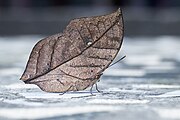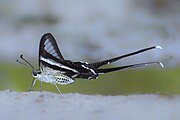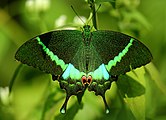Wiki Loves Butterfly
    
|

|
| Home | Team | List | Gallery | Media |
|
Butterflies have always fascinated humankind by their bright colors, which always charm the human eyes. Their beauty, seemingly amazing metamorphosis and carefree flight spark our imagination. Amidst the world of insect, butterfly are undoubtedly the most popular and celebrated group. Probably, that is the reason of their being the most studied insect. In course of prolonged researches done in this field, Lepidopterist and researchers have accumulated a great deal of information on their Taxonomy, migration, seasonal variation, polymorphism, sexual dimorphism, morphology, Behavioral natures, evolutionary biology etc. The biological existence of butterfly is not merely ornamentor of mother nature. They are one of the role makers of immense vitality to ecology and environment. There runs a co-evolutionary bonding between butterfly and the floral world. Butterflies provide a wide range of environmental and ecological benefits and issues. They are the prime most diurnal pollinators. They are monitored by scientist as a model organism for observing more widespread effect of climatic changes and environmental degradation. They are furthermore, pollution indicators and ecological indicators of healthier eco-system. Now-a-days several species of butterflies are employed by conservation biologist as an indicator species to identify habitats that are critical and needed to be protected. As wildlife indicator, they indicate a wide range of other invertebrates which comprise over two-third of all species. There runs many fold threats to butterflies. Over rapid industrialization, land degradation, continual loss of forests and grassland due to rapid urbanization, habitat deterioration, mining, widespread use of pesticides, climate changes because of growing pollution etc. play negative role with the diversity of the multi-color wingers. The number of butterfly species under the schedules of Wildlife Protection Act, 1972 is too alarming. Hence, conservation of butterfly is a burning issue at present calling for urgent attention. Next merely mass awareness, but global mass participation and involvement too is required for butterfly conservation apart from the doings of the existing conservationists. Habitat re-orientation, developing new habitats in parks, gardens and unused lands, host plant and nectar plants nurturing, roof-top gardening in conjected areas, minimizing pollution abandoning domestic and chemical waste, avoiding pesticides etc are essentially effective measure to be undertaken to save and conserve butterfly population and species. To the multi-colored and texturous kingdom of butterflies so many genus and or species and subspecies are found and so many unfound in India. Insufficient data gap leads to a lack of knowledge sharing in this realm. Hence necessity arise in contributing, developing and sharing knowledge on butterflies by way of write ups and photo uploading of butterflies and different stages of their life cycle, their behavioral patterns, about their host plants etc. Moreover it is imperative to endeavor to identify which species are found in eastern and north-eastern part of India. The overall purpose of Wiki Loves Butterfly project is to increase the amount of free license materials regarding available butterfly species of eastern and north-eastern part of India and related documentation and photographs in Wikimedia Commons and develop the quality and quantity of Wikipedia articles in this regard and particular documentation of rarely available species of any location of eastern and north-eastern part of India to be contributed in Wiki species. The WLB project further aims at broad spectrum of outreach programme, knowledge sharing and interest growing among people about Butterflies as well as of Wikipedia, Wikimedia commons, Wiki species, contributing quality images on butterfly related events to Wikimedia commons involving more users. Apart from that the Wikimedia movement and local chapters will gain visibility and impetus through the success of this WLB project. |
